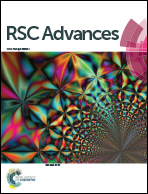Carbazole-based gold(i) complexes with alkyl chains of different lengths: tunable solid-state fluorescence, aggregation-induced emission (AIE), and reversible mechanochromism characteristics†
Abstract
In this paper, seven carbazole-based mononuclear gold(I) complexes with alkyl chains of different lengths have been synthesized and reported. All of these gold(I) complexes exhibit outstanding AIE characteristics. Furthermore, these various solid-state light-emitting AIE-active gold(I) complexes all show reversible mechanochromic fluorescent behaviors. The possible mechanism explaining these interesting AIE and mechanochromism phenomena involves a variation in weak multiple intermolecular C–H⋯F and π⋯π interactions and the formation or alteration of aurophilic interactions.


 Please wait while we load your content...
Please wait while we load your content...